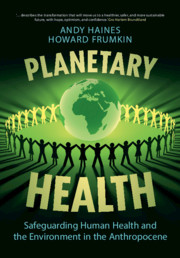Book contents
- Planetary Health
- Reviews
- Planetary Health
- Copyright page
- Contents
- Preface
- Acknowledgements
- 1 Our Changing Planet
- 2 Climate Change
- 3 Pollution, Land Use, Biodiversity, and Health
- 4 Assessing Vulnerability and Risk in the Anthropocene Epoch
- 5 Adaptation and Resilience to Planetary Change
- 6 Addressing Conceptual, Knowledge, and Implementation Challenges
- 7 Health in the Sustainable Development Goals
- 8 Transforming Energy and Industry: Towards a Net-Zero Circular Economy for Health
- 9 Sustaining Urban Health in the Anthropocene Epoch
- 10 Food Systems and Land Use
- 11 The Role of Health Professionals in Fostering Planetary Health
- 12 Sustaining Planetary Health in the Anthropocene
- Index
- References
11 - The Role of Health Professionals in Fostering Planetary Health
Published online by Cambridge University Press: 01 July 2021
- Planetary Health
- Reviews
- Planetary Health
- Copyright page
- Contents
- Preface
- Acknowledgements
- 1 Our Changing Planet
- 2 Climate Change
- 3 Pollution, Land Use, Biodiversity, and Health
- 4 Assessing Vulnerability and Risk in the Anthropocene Epoch
- 5 Adaptation and Resilience to Planetary Change
- 6 Addressing Conceptual, Knowledge, and Implementation Challenges
- 7 Health in the Sustainable Development Goals
- 8 Transforming Energy and Industry: Towards a Net-Zero Circular Economy for Health
- 9 Sustaining Urban Health in the Anthropocene Epoch
- 10 Food Systems and Land Use
- 11 The Role of Health Professionals in Fostering Planetary Health
- 12 Sustaining Planetary Health in the Anthropocene
- Index
- References
Summary
Environmental change will pose numerous challenges to health systems, as described in earlier chapters. They will need to become more resilient to shocks, including extreme events, and be able to detect and respond to changing patterns of disease (see Chapter 5). This chapter describes four major ways in which health professionals can catalyse rapid decarbonization of the economy and support moves to live within planetary boundaries while protecting health: reducing the burden of preventable ill-health; reducing the environmental impact of health care; contributing to slowing population growth; and providing broader societal leadership.
- Type
- Chapter
- Information
- Planetary HealthSafeguarding Human Health and the Environment in the Anthropocene, pp. 360 - 378Publisher: Cambridge University PressPrint publication year: 2021



